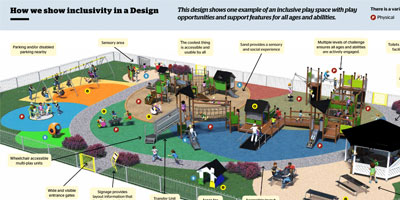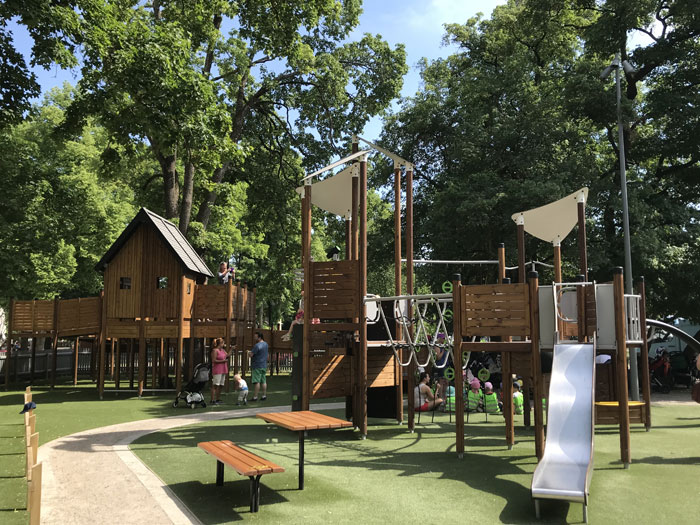Fill your basket with products by clicking "Add to my collection" from any product page. This can be found either within the product options panel or below the product image. Collections can be saved, and stored, within your HAGS Connect account or create and print your own custom brochure, download the files you need in one go, or to request a quote.
How to make the layout of your playground accessible and inclusive
An inclusive playground should provide people of all abilities inclusive access and the opportunity to move throughout the play space safely and independently. It should also enable all children to play together.
In order for this to be done, accessibility and inclusion through the placement of play equipment and other features on the play space and in the surrounding environment must be considered, such as:
- Choosing the surfacing that best meets the needs of the users
- Creating an orientation path so users can survey the play space before entering
- Designing the playground so that parents can easily find their child
- Using signage to help everyone find their way around the playground
- Installing perimeters and boundaries
- Creating play zones and gathering spaces

Surfacing and general layout
To make your playground accessible and inclusive it’s important to choose surfacing that best meets the needs of the users, this will be covered in more detail in “How to make an inclusive playground accessible” section. You can also read more about the different types of playground surfacing here.
Choose appropriate surfacing materials that meets the EN 1176 and EN 1177 standards. Playground surfaces are designed with various purposes in mind, including play value, to reduce severity of injury from falls, access and aesthetics.
Do keep in mind that many children require extra space to manoeuvre around play equipment, consider those using mobility aids, children who require adult assistance, children with poor balance, tactile sensitivity or who have trouble understanding where their bodies are in space, while those who are visually impaired may use the extra space to play independently.

Entry way and orientation
Give people the ability to familiarise themselves to the play space before directly encountering the activities and sensory stimuli. This is particularly important for people on the Autism spectrum.
On-site signage and web based information can allow individuals to familiarise themselves with the play space, layout, features and activities before they arrive to the play area.
If you are planning a large play space, it would be ideal to provide signage with a plan view of the area and a site map defining individual site features and activities for users to assess prior to entering the play area.
Creating an orientation path
By creating an orientation path, users are able to survey the play space and play zones prior to engaging, enabling them to assess the amount of physical and social contact they might expect.
Orientation paths can also act as a safe zone where children can easily move to if their anxiety rises and re-enter the play area when they are ready.
An orientation path can either surround the play zones, or be placed as a central spine from which the zones originate. The image below of a playground in France shows an example of the latter. Of course, the shape and size of the orientation path can vary depending on location, size and setting of the play space.
The path should be firm, accessible, even and predictable. It should be wide enough so that two people using mobility aids can easily pass one another and be kept free of barriers with clear line of sight along the path. Make it clear where the path ends, and the play area begins by providing visual cues such as bright yellow strips at the edges or a different texture at the edge of the path.

Providing maximum visibility
Design the playground so that parents or carers are able to see where their child is when they look from almost any point on the orientation path.
This is particularly important for children who run if over-stimulated, it also helps adults responsible for more than one child to easily find them.
When there are many play zones, make sure that the line of sight crosses each zone and maximize the use of “see through equipment” such as equipment with an open structure, windows, rope structures, etc.
Wayfinding
Wayfinding allows everyone to find their way around and through the play space. This can be achieved by:
- Creating multi-sensory signals and cues in the play space and surrounding environment
- Providing a tactile map of the area for people with visual impairment or those who are not able to read
- Using signage to direct people to specific places in the play space such as water fountains, toilets, etc.
- In large play spaces, you can consider creating signature sounds for different zones
Successfully designing to promote wayfinding allows people to determine their location within a setting, determine their destination and develop a plan that will take them form their location to their destination.
How to use colour as a tool for wayfinding and safety
You can use contrasting colours between equipment and the orientation path. Using different colours of surfacing materials, such as one colour for the fall zone and another outside the fall zone, helps children determine what might happen where. You can also use patterns and textures to make it easier to distinguish between colours, especially for someone who is colour blind.
This playground in Galashiels, Scotland, used different colours of surfacing which helps guide children around the playground and play equipment, as well as providing them with further play value.

Perimeters and boundaries
These can vary depending on the location and user groups. Some children are inclined to move themselves away from stimulation or are less able to judge danger in the environment. While others feel safer in contained spaces than open ones. Parents and carers may find it easier to supervise children in a contained space.
Carefully consider the purpose of the perimeter or boundary for the specific location and what they could bring aside from containing the site, perhaps they can also add an aesthetic element and/or play value.
Some sites may require a complete boundary, others partial boundaries and others none at all. Perimeters can be created by using walls, fences, landscaping or topography, but never use water. Use materials and colours that can be easily seen and try to consider designs that make the fence a playful, sensory or aesthetic feature of the play space.
If installing perimeters, ensure that gates or openings are clearly identifiable and are wide enough to allow maintenance access. Consider installing seats near fence openings to make supervision easier for adults.

Creating play zones
For a large play space, it makes sense to divide it into areas, for example, separating vigorous play from quiet play areas and grouping similar types of play equipment in each zone.
Bear in mind that the way that children play isn’t separated in this way, so while zones are about creating a range of opportunities, children may choose to use them differently.
Gathering spaces
Create gathering spaces in your play space to encourage the community to use it, building community spirit and reinforcing the role of play spaces as a community resource. Incorporate seating, gazebos and pavilions in places where parents and carers can both see their children and socialise.
Think about using seating, play equipment, play features, or other landscaping features to create gathering places throughout the play space.

Gala Park, Galashiels
HAGS were invited by the Scottish Borders Council to tender for part of the various proposed play park upgrades they have planned throughout the county, the first being Gala Park in Galashiels.
Read MoreInclusive Pirate Themed Playground, Burgos, Spain
HAGS designed and developed an inclusive playground in the city of Burgos for children of all abilities to enjoy, creating a comfortable play area for both children and parents.
Read MoreInclusive Tree House Themed Playground, Sweden
A fantastic inclusive playground in the city of Uppsala, Sweden, featuring a tree house-themed customised UniPlay unit.
Read MoreNature Inspired Inclusive Playground, Australia
The new nature-based playground at the Bundaberg Botanic Gardens in Australia has won the State Award for Best Playscape Award (under $500,000) in the Park and Leisure Australia Awards of Excellence program. This now progresses through the national award finals to be decided in October 2019.
Read More
HAGS Aneby AB
Grännavägen 7 578 33 Aneby
Contact Us
If you have questions or would like to know something about our products, you can contact us by phone, fax, email or directly on our website. If you do not know who at HAGS you should talk to, or if you would like to come in contact with a specific person at HAGS, you are welcome to call our switchboard to get connected to the right person.







.jpg)






































































Follow HAGS: